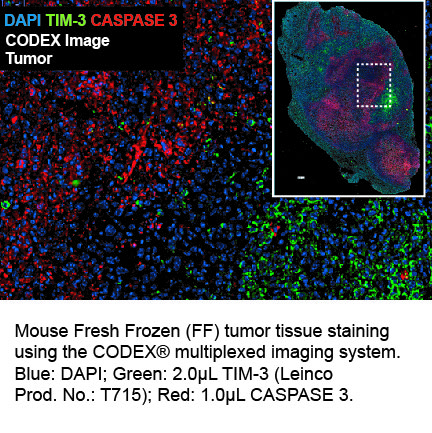Anti-Mouse TIM-3-BX003 (RMT3-23); Alexa Fluor™ 647-RX003
Antibody Isotype:
IgG2a κ
Antibody Clonality:
Monoclonal
Applications:- Immunohistochemistry- Frozen Section (IHC-F)
- Spatial Biology
Storage:
This Phen°Cycler-Fusion (CODEX)® barcoded antibody is stable when stored at 2-8°C for up to 1 year (do not freeze). The CODEX® reporter is stable when frozen at -20°C for up to 1 year.
No additional charges, what you see is what you pay! *
Stay in control of your spending. These prices have no additional charges, not even shipping!
* Rare exceptions are clearly labelled (only 0.14% of items!).
Multibuy discounts available!
Contact us to find what you can save.
This product comes from:
US.
Typical lead time:
14-21 working days.
Contact us for more accurate information.
- Further Information
- References
- Show All
Further Information
Tim-3 is expressed on activated Th1 and Tc1 lymphocytes, CD11b+ macrophages, Tregs, NK cells, and mast cells.
AlexaFluor 647, PhenoCycler®
This PhenoCycler-Fusion (CODEX)® barcoded antibody is formulated in phosphate buffered saline (150 mM NaCl) PBS, EDTA pH 7.2 containing 0.09% sodium azide as a preservative. The CODEX® reporter is lyophilized and formulated in 1X Tris-EDTA (TE) pH 8.0 (10 mM Tris-HCl, 1 mM disodium EDTA, pH 8.0)
This PhenoCycler-Fusion (CODEX)® barcoded antibody is formulated in phosphate buffered saline (150 mM NaCl) PBS, EDTA pH 7.2 containing 0.09% sodium azide as a preservative. The CODEX® reporter is lyophilized and formulated in 1X Tris-EDTA (TE) pH 8.0 (10 mM Tris-HCl, 1 mM disodium EDTA, pH 8.0)
This antibody was produced using recombinant mouse TIM-3
Antibody Tim-3, clone RMT3-23, recognizes T cell immunoglobulin and mucin domain-containing protein 3 (TIM3, also known as CD366), a TIM family member of immunoregulatory proteins. Tim-3 is a 60kDa type I transmembrane protein with an extracellular immunoglobulin and mucin-like domain and a cytoplasmic tyrosine phosphorylation motif. Tim-3 is expressed by IFNg-producing Th1 CD4 and Tc1 (cytotoxic) CD8 T cells1, regulatory T cells (Tregs)2, myeloid cells3, NK cells4, and mast cells5. Tim-3 is an inhibitory molecule that limits Th1-mediated inflammatory diseases, including a model of central nervous system inflammation (experimental autoimmune encephalomyelitis, EAE)1, inflammatory bowel disease (IBD)6, and type I diabetes7. Tim-3 is also proposed to induce immunological tolerance7, promote Th1 apoptosis8, and regulate macrophage activation1. In addition, Tim-3 is upregulated on tumor-infiltrating lymphocytes, and coblockade of Tim-3 and immune checkpoint inhibitors, such as PD-1, is currently being investigated in clinical trials for the treatment of cancer9.
PhenoCycler-Fusion (CODEX)® reporters are made up of a fluorescent dye and a short oligonucleotide DNA barcode called a CODEX® Tag. Fluorescent reporters enable highly specific detection of corresponding barcodes, and the use of spectrally separated dyes allow for precise signal detection in up to three distinct fluorescence channels at one time.
171285
Tim-3



